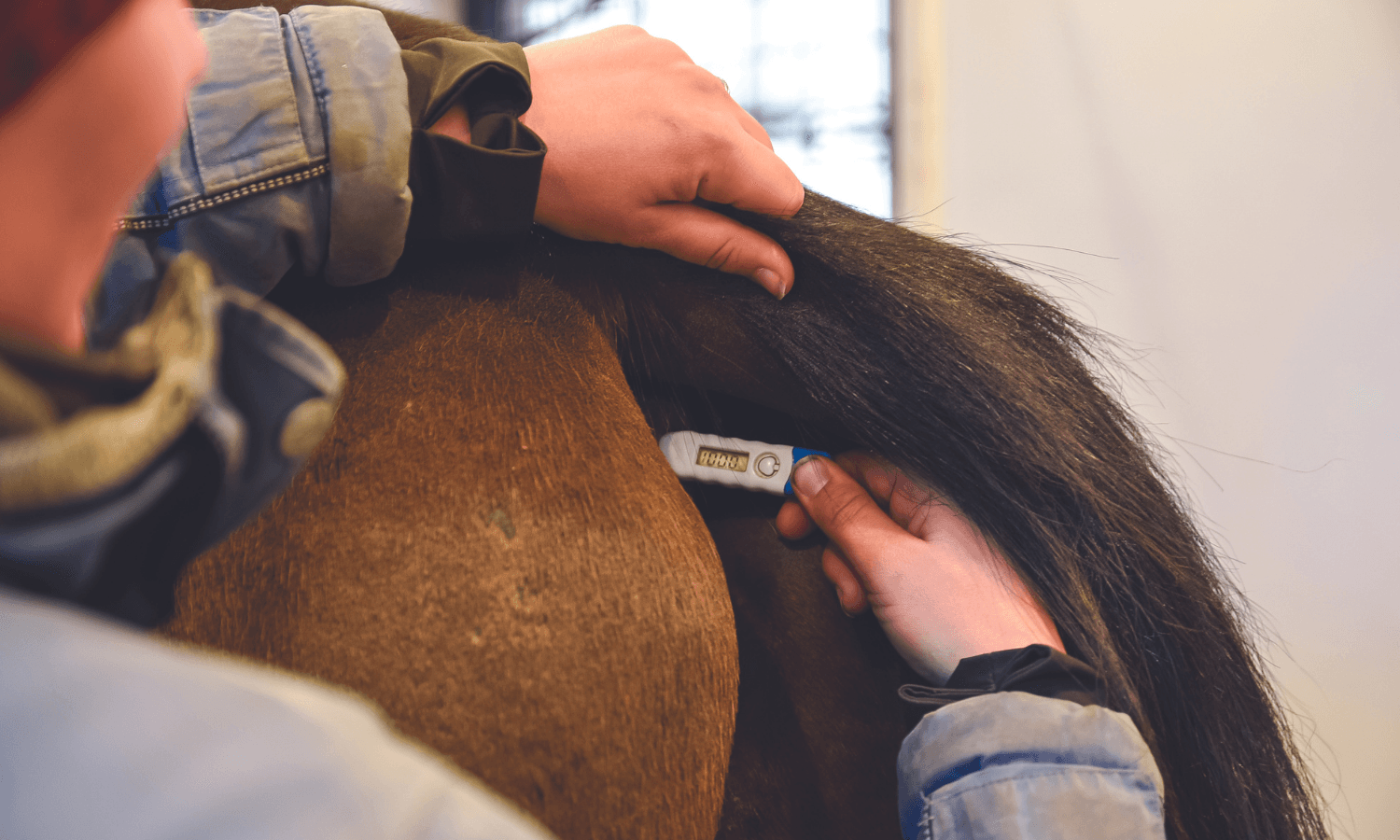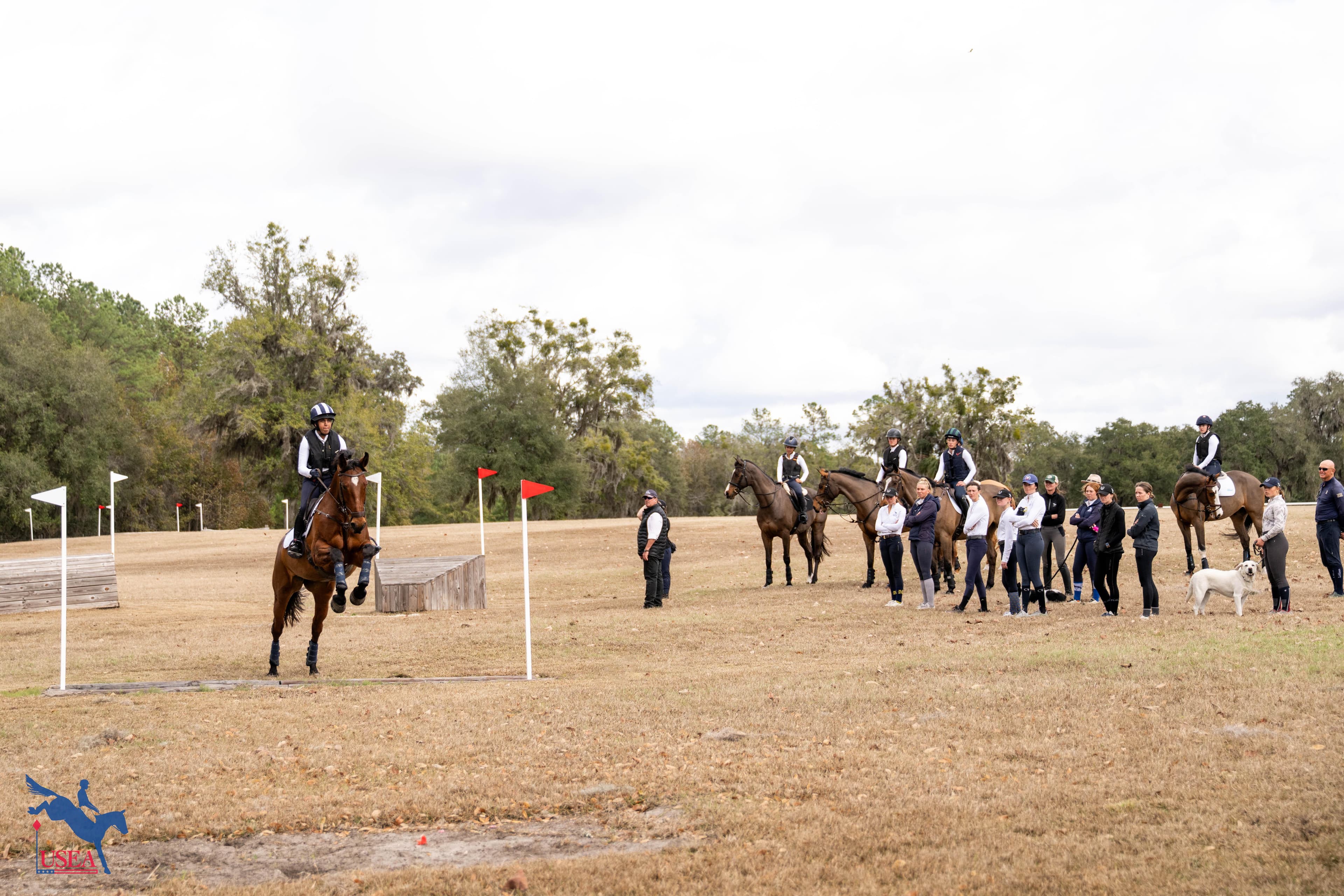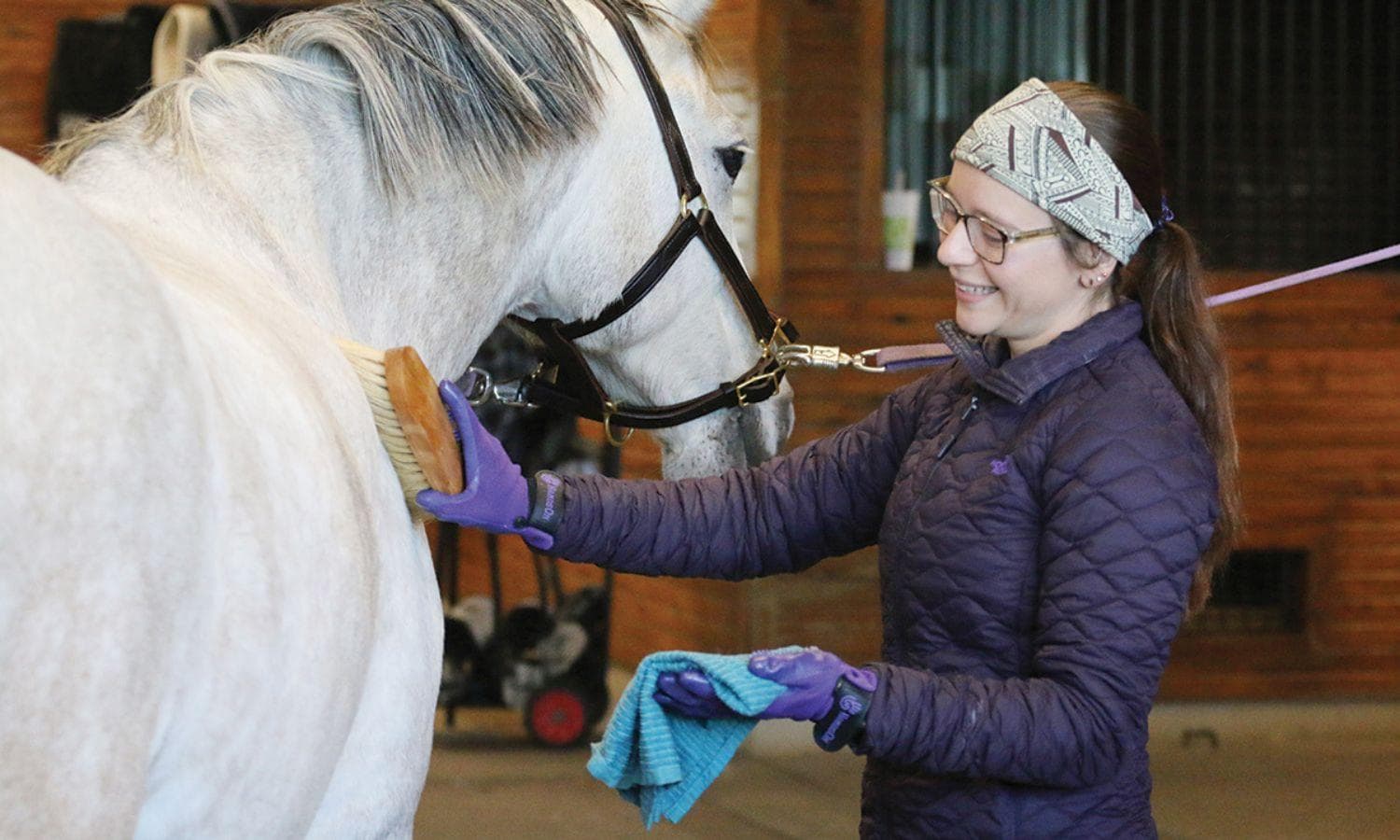My Horse Has a Fever: Now What?

This article originally appeared in the 2021 Issue 1 of Eventing USA magazine.
“As a hands-on horse owner, you know your animals better than anyone,” began Dr. Elizabeth MacDonald, Clinical Instructor of Equine Medicine at Virginia Tech’s Marion duPont Scott Equine Medical Center in Leesburg, Virginia. “So, when your horse is a bit slow coming in from the field, not as excited as normal, not interested in finishing their meal, you know something’s wrong. The first thing you can do is check your horse’s vital parameters, and checking a rectal temperature is something everyone can easily do.”
An adult horse’s normal temperature can range anywhere from 98 degrees Fahrenheit to 101 degrees Fahrenheit. “Most horses have a very narrow spectrum that they run in,” MacDonald elaborated, “so it’s very important that you know what is normal for your horse.” MacDonald recommended regular monitoring of your horse’s temperature to become familiar with what is normal for him. Knowing what is normal for your horse can make it easier to spot when there’s a potential problem.
“[An elevated temperature] is an early warning sign that you may need to pay close attention,” MacDonald continued. “It may return to normal with no other signs, or it will potentially continue to increase. We don’t consider a horse to have a true fever until the temperature gets above 101.5 [degrees Fahrenheit].”
How Does the Body Maintain a Normal Temperature?
A horse’s body temperature is controlled and regulated by the hypothalamus, a small structure at the base of the brain – it is essentially the thermostat of the body. There are receptors all over the body that send signals to the hypothalamus telling it what normal temperature should be and if that normal temperature is being maintained.
When the hypothalamus receives information that the body’s temperature is drifting away from normal, it triggers a number of different responses to “adjust the thermostat” and bring the temperature back into a normal range. “If the horse is getting too hot, signals are sent out from the hypothalamus to relax the muscles that control the coat hairs so the hairs lie flat and don’t trap air in between the skin and the hair,” explained MacDonald. “It also adjusts blood flow to the skin – if the horse is hot, there is an increased amount of blood flow to the skin surface and vessels dilate and become bigger, helping heat dissipate more rapidly. If the horse continues to get even hotter, that’s when we see sweating.”
“The reverse happens if we have a horse that’s getting too cold,” MacDonald continued. “If the hypothalamus receives signals that the body is getting cold, we have muscle contractions that control the hairs and lifts the hairs up away from the skin surface to trap an insulating layer of air between the hair and the skin surface. Vasoconstriction – where the blood vessels that are running to the skin surface will get smaller – there will be less blood flow going to the skin surface so the horse won’t lose as much heat as rapidly. If those changes don’t make enough of a difference, that’s when the horse starts to shiver. There are also metabolic changes as well – if the horse is really cold it will stimulate the release or hormones to increase metabolism, causing the organs to work a bit harder to produce heat.”
Does Your Horse Have a Fever?
If you check your horse’s temperature and it appears to be outside your horse’s normal range, MacDonald said that you first need to determine if your horse is experiencing hyperthermia, an elevated temperature, or pyrexia, a true fever.
Hyperthermia occurs when the hypothalamus is telling the body it needs to be a certain temperature, but the body’s actual temperature is higher than that. This can be caused by intense exercise, extreme heat or humidity, anhidrosis, or as reaction to certain toxins or drugs. Severe hyperthermia is also known as heat stroke.
Pyrexia occurs when the hypothalamus has turned up the thermostat, signaling the body to increase the temperature above the normal range. “This is one of the first signs we see when the body is fighting an infection or has a problem because this is the immune system’s influence on the hypothalamus.”
The Body’s Response to a Fever
A fever is one of the body’s defense mechanisms in response to an infection. MacDonald said that a fever is a good sign – it means that the body is responding appropriately to a foreign invader. When the immune system encounters a pathogen, bacteria, or virus it doesn’t recognize, the white blood cells release cytokines, or blood-born messengers, to alert other systems in the body of the foreign invader and trigger the appropriate response. One of these cytokines is called a pyrogen, and the pyrogens get picked up by the hypothalamus and tell it to turn the temperature up.
Sensing that the body’s actual temperature is below the desired temperature, the hypothalamus will respond as though the body is cold. “Muscles contract to control the hair and puff up the hair coat to trap an insulating layer of air, the blood vessels that come to skin surface constrict so there isn’t as much heat dissipating, and the horse might start to shiver,” MacDonald said. “The metabolism will increase as well, making the organs work a bit harder and produce a bit more heat.”
As the body’s immune response begins to clear the infection from the body, the white blood cells will stop releasing pyrogens and the hypothalamus, sensing the decrease of pyrogens in the blood, will signal the body to return to a normal temperature.
When to Call the Vet
Once you have determined that your horse does indeed have a fever, MacDonald says your first step should always be a call to your veterinarian. “Put it on their radar,” MacDonald suggested. “It doesn’t always mean that they’re going to rush out to see your horse, but they can advise you based on what your horse is doing and the information you’re giving them.”
If you pick up the fever as part of a regular daily screening and your horse is otherwise eating and drinking normally, your vet may advise you to simply continue to monitor for the time being and keep an eye out for other symptoms. However, if the horse is showing other signs of illness, it may be necessary for your horse to be seen by the vet immediately. “In this case, early evaluation and treatment may give you a better prognosis,” MacDonald advised.
The decision by your veterinarian to see the horse immediately or not will also be advised by your horse’s general health history, recent health concerns like nasal discharge or mild colic, any medications your horse takes regularly, recent travel, or environmental changes like a new pasturemate. “If your horse’s fever persists, or other clinical signs are present, your veterinarian is going to want to see your horse,” MacDonald said.
Identifying the Fever’s Underlying Cause
If you and your veterinarian determine that your horse needs to be seen to identify what’s causing your horse’s fever, the vet will start with a full physical examination. “Sometimes, based on this physical exam, we can get clues about where the infection is based and then target our approach,” MacDonald said. “Other times, the exam is completely normal and we have to take the next step, which is often bloodwork.”
“A complete blood count (CBC) looks at the white blood cells, which are responsible for fighting infection, and may give us a clue,” MacDonald continued. “Serum chemistry will look at the liver and kidney parameters along with muscle enzymes and might provide some insight into which body system is affected. You might also run a fibrinogen or serum amyloid A, which are nonspecific markers of inflammation. If they are elevated, we have further evidence that there is something more going on in the body that we need to keep looking for.” MacDonald said that bloodwork can also be used as a monitoring tool once the problem has been identified. Nasal swabs and fecal samples may also be used as diagnostic tools.
If that first round of diagnostics turns up nothing, or more investigation is required, more invasive diagnostics can be employed. These include ultrasounds of the heart, lungs, and gastrointestinal tract and fluid samples from the internal organs or spinal fluid.
Treating the Fever
“There’s no set recipe that we can provide every horse,” MacDonald said when discussing different treatment options for fever, “because every horse is different and the underlying cause is different.”
If you detect a fever as part of your routine screening and your horse is otherwise behaving normally, MacDonald advised that you might do nothing but continue to monitor the fever, and your horse, for any changes. “A slightly elevated temperature that only lasts for a day or two generally is of no harm,” said MacDonald. “The body is doing what it’s supposed to be doing to clear an infection. Let your horse rest, continue to monitor, and let the immune system do its job.”
However, if your horse is showing other clinical signs, you and your vet may decide that it’s appropriate to administer some non-steroidal anti-inflammatory drugs (NSAIDs) like bute or banamine. “We don’t want the horse to feel so poorly that he doesn’t want to eat or drink because that can cause secondary complications,” said MacDonald. “If they continue to look after themselves, the non-steroidal anti-inflammatories will make them feel better and help bring their temperature down. Every horse is different, so we have to look at each horse individually.” If the NSAIDs aren’t bringing your horse’s fever down, you can try things like cold-hosing or putting them in front of a fan to help bring their temperature down.
If you have a diagnosis for what has caused the fever, your horse may require antibiotics. However, antibiotics are typically reserved for horses where the cause of the fever has been identified and is known to respond well to antibiotics.
There are situations where it is necessary to transport your horse to the hospital for observation and treatment. “Not every horse with a fever needs to go to the hospital, but there are times when it is essential,” MacDonald said. “If you have a horse who is not responding to initial treatment on the farm five days in, that might mean you need further investigation, and not every veterinarian can do that on the farm. There might also be herd health concerns – if your veterinarian has a strong suspicion of infectious disease that could spread rapidly through the herd and your barn is not set up to have an isolated area you might be referred to a hospital to get that horse in a safe, isolated environment.” Another reason MacDonald noted was the risk for complications that come with diseases that cause fevers. In these cases, being at a hospital where the horse can receive the care they need can be life-saving.
Ultimately, MacDonald said, “The way your veterinarian approaches the treatment of your horse will depend on what they find in their examination and what they think your horse might have – there’s no ideal recipe, it’s all based on what the horses show us.”
“Fever is a symptom suggesting there’s an underlying problem, and there are a large number of potential underlying causes,” MacDonald concluded. “A mild fever might leave your horse feeling sluggish and quiet for a few days – just let them rest and monitor them closely. We know the immune system is responding and most of them will bounce back in a day or two. If you identify a fever, continue to monitor your horse closely so that you can pick up any changes. And always reach out to your veterinarian to decide on the best course of action – reaching out to them early puts it on their radar, they can monitor closely with you and give you advice and if things aren’t responding appropriately you can be ready to take the next step of investigation.”
About Elizabeth MacDonald, BVMS, MS, Diplomate ACVIM (LAIM)
Dr. MacDonald earned a Bachelor of Arts in biology from Skidmore College in Saratoga Springs, New York, before completing a Bachelor of Veterinary Medicine and Surgery with honors at the University of Glasgow in Glasgow, Scotland. She also completed a Master of Science in biomedical and veterinary sciences from the Virginia-Maryland College of Veterinary Medicine in 2015.
Prior to being named a Clinical Instructor at Virginia Tech’s Marion duPont Scott Equine Medical Center (EMC), Dr. MacDonald completed an internship at the New England Equine Practice in Patterson, New York, and a residency in large animal internal medicine at the EMC. She maintains professional memberships with the American Veterinary Medical Association (AVMA) and American Association of Equine Practitioners (AAEP).
Did you enjoy this article? Want to receive Eventing USA straight to your mailbox? Members receive Eventing USA as part of their USEA Membership or you can purchase individual issues from the USEA Shop.














